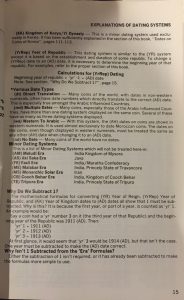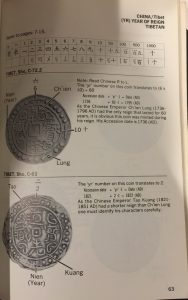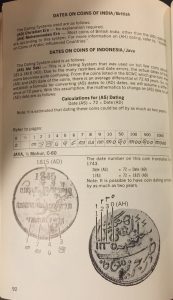Jul 18, 2022 | books, Canada, coins, news
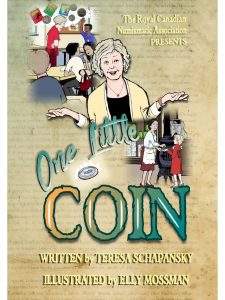 As the times change, traditional hobbies have to find new ways to reach a new audience. The Royal Canadian Numismatic Association (RCNA) tried something different and published a new children’s book.
As the times change, traditional hobbies have to find new ways to reach a new audience. The Royal Canadian Numismatic Association (RCNA) tried something different and published a new children’s book.
The RCNA teamed up with best-selling Canadian author Teresa Schapansky and award-winning artist Elly Mossman to produce a children’s book, One Little Coin. The book is about a child’s adventures in joining a coin club and what happens.
Here’s the publisher’s blurb:
Dear Journal, I signed up for the coin club, because to be honest, I really like money. Wasn’t that what a coin club was about? Money? That, and how to get it, how much to keep and how much to spend? I glanced around the room, and easily saw that the class was made up of quite an assortment of kids – polar opposites, in my opinion. In the end, who could have guessed that seven totally different kinds of people would form such an unlikely bond in a coin club? Maybe one day, I’ll find one little coin that will change my life, forever. Maybe I’ll find it with Jacques’s metal detector, or maybe it’ll be stuck in some couch cushion. The possibilities are endless.
The book includes “Miss Cassidy’s Guidebook,” a guide to coin collecting for young readers.
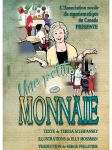 One Little Coin is written in English and in French as Une Petite Monnaie.
One Little Coin is written in English and in French as Une Petite Monnaie.
Book publishing is always a risk. A publisher once told me that less than 10-percent of the books they publish make a significant profit. The RCNA is taking a risk by publishing a children’s book in a society where parents opt for electronic entertainment.
I hope it works. If it does, I hope it inspires others to find new ways to reach collectors.
And now the news…

July 9, 2022
There are some $200 bills that were put into circulation in October 2016 by the Central Bank of the Argentine Republic (BCRA) that have a particular production error for which numismatic specialists and collectors in the field paid attention to them.

→ Read more at
california18.com

July 12, 2022
<em>One Little Coin</em>, the latest book by Duncan, B.C.’s Teresa Schapansky, topped the Amazon Hot New Releases list for coins and medals this June. The Royal Canadian Numismatic Association (RCNA) published the digital version of the book in both English and French on June 22.

→ Read more at
canadiancoinnews.com

July 14, 2022
The new P1,000 polymer banknotes, another legacy left to President Bongbong Marcos by his predecessor, came as a surprise parachute drop on a market that appears to be not adequately prepared.

→ Read more at
philstar.com

July 15, 2022
It’s possible you might be able to find coins worth in the thousands around your home or anywhere you store change. The value of your coins could depend on a few factors including mintage, grade and condition, as well as errors.

→ Read more at
the-sun.com
May 9, 2022 | books, coins, education, poll
 I am getting ready to open the next chapter of my life, and I was thinking about how I can leverage my knowledge and experience to enhance the collecting community. As an experienced collector of all types and a dealer in areas other than numismatics, I learned a lot about collectors and their habits that could benefit a general audience.
I am getting ready to open the next chapter of my life, and I was thinking about how I can leverage my knowledge and experience to enhance the collecting community. As an experienced collector of all types and a dealer in areas other than numismatics, I learned a lot about collectors and their habits that could benefit a general audience.
As I was thinking about sharing my experiences, I wondered where most people learned about their collectibles. But the resources I had are different than those available today. Even the way we take in and understand knowledge is different. I thought it would be interesting to ask the numismatic community how they learn about collecting.
So let’s ask the question:

Loading ...
Sep 29, 2020 | books, poll
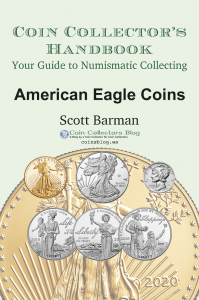 Over the weekend, I received the report telling me how many people downloaded my new e-book Coin Collector’s Handbook: American Eagle Coins. Thank you to everyone who purchased a copy! If you have not purchased your copy, you can do so today. For $9, the e-book is a description of the American Eagle Program from its inception in 1986 through 2019 without the fluff.
Over the weekend, I received the report telling me how many people downloaded my new e-book Coin Collector’s Handbook: American Eagle Coins. Thank you to everyone who purchased a copy! If you have not purchased your copy, you can do so today. For $9, the e-book is a description of the American Eagle Program from its inception in 1986 through 2019 without the fluff.
Did you know that the book described all of the special issue American Eagle coins, including anniversary and partnered series like the Legacies of Freedom set? There are mintage figures for every coin and set in the book. I plan to update the book annually, including updated mintage figures and new designs.
Now, it is time to move on to another guide.
The Guides are designed for the collector to add to your collecting experience. They provide essential information that every collector wants to know without a lot of extra details.
I started with the American Eagle coins because it generates the most interest on the bog. For the next guide, I have taken a few of the topics of interest, sorted the list, and will ask you, the readers, what you would like to see next.
A Field Guide to Detecting Counterfeits and Scams will be written for the everyday collector to understand how they can protect themselves. The Guide will explain how to look at the coin and pictures of coins at the strike, understand why you should understand precisely how a coin is to look, and what to do if you buy a counterfeit coin. This Guide will also look at the over-promising sales pitches some companies use, especially on television, that causes people to overpay.
Guide to Modern U.S. Circulating Commemorative Coins will look at each of the changing coins produced since 1999. It will cover every coin from the 50 State Quarters Program through Innovation Dollar with descriptions, design, mintage figures, and more. The book will include other related collectibles produced by the U.S. Mint, including coin covers and the 50 State Quarters Bears.
Guide to Defining Your Own Collection has been a popular question since I posted a redefinition of the Lincoln Cent Type Set. Since asked from creating different type sets, there were other ideas based on different themes. How about a collection of American buffalos or bison? Birth year sets are common, but what about collecting world coins from every year of your birth? Over the years, I have collected many different ideas for creating more than coin collections.
Guide to Modern Dollar Coins beings with the Eisenhower Dollars, the last series of large dollar coins, and continues to the Native American and Innovation dollar coins. In between, there are a lot of stories, controversies, composition changes, and presidents. Although the coins are easy to collect, this guide will add to your appreciation of these coins.
Something else tells me that you are interested in another topic. It does not have to be something that fits into a narrow topic. Most collectors have a broad interest that cannot be classified into a neat topic. I am willing to explore something out of the ordinary.

Loading ...
Sep 14, 2020 | administrative, books
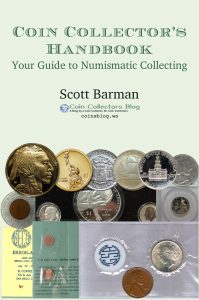 Today I am announcing the Coin Collector’s Handbook release and the Coin Collectors Handbook Series of Guides.
Today I am announcing the Coin Collector’s Handbook release and the Coin Collectors Handbook Series of Guides.
Since writing the first article on the Coin Collectors Blog in October 2005, I shared my collecting experiences and collected knowledge with his worldwide audience. After 15 years, it was time to give back to the hobby by creating a guide book based on my experience.
The Coin Collector’s Handbook is by a collector from the perspective of a collector. The book takes the most popular posts and pages from the blog and republished them in book form for the average collector regardless of what you collect. I want to see people enjoy collecting coins or anything else they like without being told that they must create a specific set.
The Coin Collector’s Handbook can be ordered online at the introductory price of $17.95 with free shipping. That is $2.00 off the list price! Just click here to order your copy.
Coin Collector’s Handbook Guides
 During the recent quarantine, collectors have been using their available time to learn more about their collections. In the last several months, the most popular posts have been about the American Eagle Bullion Program.
During the recent quarantine, collectors have been using their available time to learn more about their collections. In the last several months, the most popular posts have been about the American Eagle Bullion Program.
Using my previous posts about the American Eagle Bullion Program, posts from the blog are now available in e-book form. The book opens with an essay about the American Eagle Program’s start, followed by chapters that expand on the original posts with coin specifications, design details, and mintage statistics. It includes a glossary of terms used in the book.
Coin Collectors Handbook: American Eagle Coins is available to download as a PDF  from the blog’s new Buy Me A Coffee Shop for $9.00, just three cups of coffee!
from the blog’s new Buy Me A Coffee Shop for $9.00, just three cups of coffee!
Based on what the blog readers are clicking on, there will be more guides to come. Stay tuned!
If you like what you read, share, and show your support 
May 6, 2020 | advice, books, education
 Even as some areas of the country are easing quarantine restrictions, the best way to prevent the spread of COVID-19 is to stay home. Although the United States has 4.25-percent of the world’s population, it has 33.19-percent of the reported cases of the disease with a death rate of 5.77-percent.
Even as some areas of the country are easing quarantine restrictions, the best way to prevent the spread of COVID-19 is to stay home. Although the United States has 4.25-percent of the world’s population, it has 33.19-percent of the reported cases of the disease with a death rate of 5.77-percent.
The dangers of the novel coronavirus are not only to older people, who dominate the hobby, reports that younger people who may not have shown symptoms have experienced strokes. Even the youngest children are showing symptoms that resemble Kawasaki disease.
I know it is a financially and mentally tough situation. The business I worked hard to build was beginning to break through when Maryland ordered non-essential companies to close. When I am not working alone to organize a warehouse, I am finding solace in numismatics.
During the last few weeks, I have been reducing the to-be-read pile of books. But I am beginning to run out of books. I am looking for something different. Since I like history and tying history with numismatics, I am looking to learn something new. With a tight budget, I am also looking for something new that does not cost much.
I found four entries to my Quarantine Reading List that are interesting and have taught me something. The best thing about each of the books is that each is available online.
U.S. Mint Modern Era
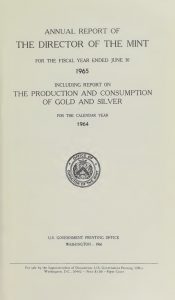 Other than the formation of the U.S. Mint, there is no single seminal event that marks its history than the elimination of silver from circulating coinage. It is the dividing line between what is considered classical coinage and the modern era.
Other than the formation of the U.S. Mint, there is no single seminal event that marks its history than the elimination of silver from circulating coinage. It is the dividing line between what is considered classical coinage and the modern era.
When you find information about the era, it discusses the discussion and the result that created clad coinage. But when you dig into the policy, there is a bigger story. As with a lot of history, the details help us understand the road to where we are today.
The road to modern coinage began with changes in the laws and policies at the U.S. Mint. The one place that every law and policy announcement documented is in the “Annual Report of the Director of the Mint Fiscal Year June 30, 1965.”
What makes this over 300-page document interesting to read are the details that are no longer present in present-day Annual Reports. The text reprints congressional testimony, reports, announcements, policies, and the laws that affected the U.S. Mint. Since this report covers the last half of calendar year 1964 and the first half of calendar year 1965, it is ideally situated to document the government’s action from silver to clad coinage.
The first numbered page begins with the text of the Coinage Act of 1965.
For those that like charts and data, you can go to page 201 to read the section on “The World’s Monetary Stocks of Gold, Silver, and Coins in 1964.” It is a look at circulating coinage of the entire world for 1964. It is a fascinating view that the U.S. Mint stopped doing in 1972.
Download your copy of this Annual Report → here.
Colonial Currency
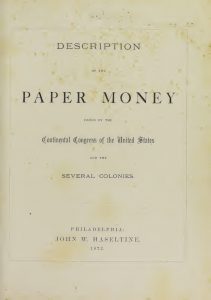 While looking for records about colonial currency, I stumbled on an electronic copy of Description of the Paper Money Issued by the Continental Congress of the United States and the Several Colonies by John W. Haseltine, published in 1872. Haseltine was a dealer, auctioneer, and cataloger of many collectibles, including coins. Many of his catalogs were sparsely illustrated, but the listings have proven invaluable.
While looking for records about colonial currency, I stumbled on an electronic copy of Description of the Paper Money Issued by the Continental Congress of the United States and the Several Colonies by John W. Haseltine, published in 1872. Haseltine was a dealer, auctioneer, and cataloger of many collectibles, including coins. Many of his catalogs were sparsely illustrated, but the listings have proven invaluable.
Paper Money Issued by the Continental Congress is one of those catalogs. Its contents are nothing more than lists of colonial currency issued in the 18th century. It is a useful reference for anyone with interest in the currency of that era. Download a copy → here.
If you want a colonial currency reference that is more extensive, you can download The Early Paper Money of America by Eric P. Newman → here.
Branch Mints and Gold Coins
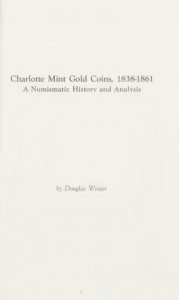 Did you know that the Charlotte Mint was the first branch mint outside of Philadelphia? Authorized in 1835 following the gold strike at the Reed Gold Mine, it became operational in 1838. The Charlotte branch mint was closed when the building was seized in 1861 by the Confederacy during the Civil War.
Did you know that the Charlotte Mint was the first branch mint outside of Philadelphia? Authorized in 1835 following the gold strike at the Reed Gold Mine, it became operational in 1838. The Charlotte branch mint was closed when the building was seized in 1861 by the Confederacy during the Civil War.
When I wanted to learn more about the Charlotte Mint, I was pleasantly surprised to discover that Charlotte Mint Gold Coins, 1838-1861 by Douglas Winter is available to read online or to download. The book is an easy read with illustrations, and a catalog of the coins struck at the mint. You can find the book → here.
The branch mint in Dahlonega, Georgia, opened after Charlotte also to mint gold coins from a nearby gold strike. Dahlonega was also seized by the Confederacy in 1861 and did not reopened.
 Gold coins minted at Dahlonega carry the “D” mintmark. Since Dahlonega only struck gold coins and gold coins were not struck in Denver, this has not been an issue. To read about the colorful history of this branch mint, read Gold Coins of the Dahlonega Mint 1838-1861, Second Edition, by Douglas Winter. The book is similar in format to Winter’s Charlotte book. You can find this book → here.
Gold coins minted at Dahlonega carry the “D” mintmark. Since Dahlonega only struck gold coins and gold coins were not struck in Denver, this has not been an issue. To read about the colorful history of this branch mint, read Gold Coins of the Dahlonega Mint 1838-1861, Second Edition, by Douglas Winter. The book is similar in format to Winter’s Charlotte book. You can find this book → here.
Winter did write books about the gold coins struck at the New Orleans and Carson City Mints, but I had not read either book at the time of this writing. These books and more free resources are available through the Newman Numismatic Portal.
Apr 21, 2020 | books
With the announcement that the coalition of northeast states will continue their stay-at-home order at least through May 15, it is time to turn off the news and think about something else.
Since the kids are doing their homework without a teacher, you can pick up a book or two and learn something about the hobby we love.
The inspiration for today’s Quarantine Reading List came from a reader asking about the history surrounding the institutions that create the numismatic products.
Although many books explain the manufacturing processes and describe the history, the goal of this list is to suggest well written and accessible books on each topic. If the publication is available online, there will be a link to read it or download a copy.
U.S. Mint
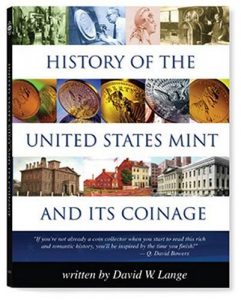 Of all the money manufacturing institutions, the U.S. Mint has the most documented history. There are so many good books about the Mint’s history it is difficult to narrow down a recommendation to one book. If you are going to read one book, read History Of The United States Mint and Its Coinage by David Lange.
Of all the money manufacturing institutions, the U.S. Mint has the most documented history. There are so many good books about the Mint’s history it is difficult to narrow down a recommendation to one book. If you are going to read one book, read History Of The United States Mint and Its Coinage by David Lange.
Whether you read for knowledge or pleasure, it is always best when it is well written. David Lange’s reputation as a great writer is on full display in this book. Using his skill, Lange writes a broad context of the history of the U.S. Mint fitting it in 190 pages with images of coins, vignettes, and documents of the time. After you finish, give the book to your young numismatist who will also enjoy it.
History Of The United States Mint and Its Coinage is no longer in print but can be found on the secondary and used book market.
Bureau of Engraving and Printing
 The Bureau of Engraving and Printing started in 1862 in the basement of the Treasury Building as the National Currency Bureau. Their first job was to separate currency notes produced by private banknote printing companies. The newly formed bureau started its printing operations in 1863.
The Bureau of Engraving and Printing started in 1862 in the basement of the Treasury Building as the National Currency Bureau. Their first job was to separate currency notes produced by private banknote printing companies. The newly formed bureau started its printing operations in 1863.
The BEP grew out of the necessity to fund the Civil War. From there, the bureau became the primary security printing service for the government. To learn more about the BEP and its growth, read History of the Bureau of Engraving and Printing. Produced for the 100th Anniversary of the BEP, the book is the most comprehensive coverage of its history.
For those looking to save money, the book is available online. It does not have copyright restrictions since it was produced by the BEP and printed by the Government Printing Office. You can download the book in many electronic formats from Newman Numismatic Portal and the Internet Archives. Download the book now and start reading!
Department of the Treasury
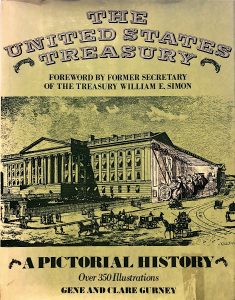 The Treasury Department is the only Cabinet-level department whose history mirrors the country’s history. Although there has been a lot written about Treasury, most of the book covers a specific era of history. Whether the subject is the founding of the department by Alexander Hamilton, the Gold Rush era, or the transition to working with the Federal Reserve starting in 1913, you can find a book that will expand on Treasury’s history.
The Treasury Department is the only Cabinet-level department whose history mirrors the country’s history. Although there has been a lot written about Treasury, most of the book covers a specific era of history. Whether the subject is the founding of the department by Alexander Hamilton, the Gold Rush era, or the transition to working with the Federal Reserve starting in 1913, you can find a book that will expand on Treasury’s history.
For a good overview that discusses the history of the department and reconizes the production of money through the years is The United States Treasury: A Pictorial History by Gene and Clare Gurney.
Written in 1978, it is not an academic study of the Treasury Department. The book provides a pictorial overview along with the story of Treasury with over 350 illustrations in 216 pages.
Of course, you can buy the book and have it as a perpetual reference. If you want to “borrow” an electronic book, you can do so at the Internet Archives. Once you create a free account on the Internet Archives, you can check out an electronic version for two weeks.
Commission of Fine Arts
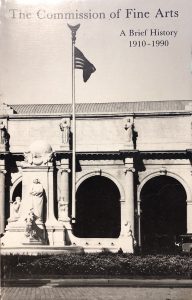 Although the Commission of Fine Arts is not part of the manufacture of money, it wields influence on the designs of the coins struck by the U.S. Mint. The first influence the CFA had on coin design was for the 1921 Peace Dollar. It was the CFA that managed and selected the competition that was won by Anthony de Francisci.
Although the Commission of Fine Arts is not part of the manufacture of money, it wields influence on the designs of the coins struck by the U.S. Mint. The first influence the CFA had on coin design was for the 1921 Peace Dollar. It was the CFA that managed and selected the competition that was won by Anthony de Francisci.
In 1976, the CFA published the initial version of the commission’s history. They produced updates every five years with the last published in 1996 that covers its history through 1995. Most of the book does not mention its ties to numismatics until the 1985-1990 additions.
It is difficult to find physical copies of the later version of the book. The most common version found on the secondary market was the one published in 1986, before their involvement with the American Eagle program. But as a government publication, it is available online at the Internet Archive. As with other electronic books downloadable from the Internet Archive, it is available in many different formats depending on your device.
SUMMARY
Reading is an excellent way to pass the time.
Stay healthy! Stay safe!
Links to purchase the books on Abe Books are affiliate links. Money earned from using the links to buy the books will help pay the blog’s hosting bill while I am not working.
Sep 24, 2019 | books, review
During the unpacking of an estate, I came across a book with the title Coin of the Canonical Realm. It is a short, 58 pages, paperback book that has an intriguing cover. As a coin collector, I started to thumb through the book to get a sense of its purpose. Since it was not apparent, I had to wait until later.
After cleaning off my desk, I found the book and decided to read the Introduction to understand the book’s purpose. According to the introduction, its purpose is to “21st century sense of all the 19th century mentions of money in the Sherlock Holmes stories.”
Sherlock Holmes was a fictional detective created by Arthur Conan Doyle. Doyle created Holmes as a “consulting detective” so that the character can appear in varying environments. Doyle was one of the first authors to create a crime-fighting character that includes all of the tools that we take advantage of today. Someone suggested that Mission: Impossible is a modern extension of the Sherlock Holmes stories.
Most of Doyle’s stories are written from the perspective of John H. Watson, M.D. as Holmes’ biographer. Watson is a friend and part-time roommate who accompanies Holmes on his investigations. Watson can be annoyed with Holmes on some of his actions while being intrigued by his actions.
During his life, Doyle wrote 56 short stories and four novels about Sherlock Holmes. The short stories are compiled in five books which I have read three of them. All of the Sherlock Holmes stories are highly recommended.
The Sherlock Holmes stories endured long after Doyle’s passing in 1930. Aside from the movies and other new media recreations, there are societies dedicated to studying the intricacies of Holmes, the crimes, and other characters Doyle included. One of those organizations is The John H. Watson Society.
The John H. Watson Society, founded in 2013, is described as an organization that will study Dr. Watson as a unique individual and how his character enhances the Doyle classics. Watson, whose background is revealed throughout the stories, is a renown physician with a heroic war record and trust by a community is leery of the medial arts.
The book, written by Nickolas Utechin whose biography describes himself as having a long history with studying Sherlock Holmes, is the first monograph published by the John H. Watson Society.
Starting from Chapter 1, Utechin copies one or two-line passages from Doyle’s writings that reference money then explains them in the context of the 21st-century. He first describes the old British monetary system where there were 240 pence to a pound including the varying minor coins that were in use at the time. (See this post for a description of the old British monetary system)
Each of the chapters covers the five volumes of compiled short stories and then four chapters for each of the novels. Although you can get the gist of what Utechin writes about, it is best to use this booklet as a companion while reading a Sherlock Holmes story.
Having this explanation while reading one of the short stories adds a different perspective to the story. For those who have not read a Sherlock Holmes story, I would recommend that you first read the story without consulting this booklet. On your second reading have this booklet nearby to help you put the story into perspective.
Some may consider Coin of the Canonical Realm a supplemental study guide to Sherlock Holmes. Whatever you want to call it, fans of the stories may find it adds to their enjoyment.
If you are interested in owning a copy of Coin of the Canonical Realm, you can order it directly from The John H. Watson Society.
Mar 18, 2019 | books, commentary, news, other
 While searching for something else, I came across a story that F+W Media, the parent company of Krause Publications, filed for Chapter 11 bankruptcy on March 10. As part of its bankruptcy filing, the company plans to liquidate its assets to pay its creditors.
While searching for something else, I came across a story that F+W Media, the parent company of Krause Publications, filed for Chapter 11 bankruptcy on March 10. As part of its bankruptcy filing, the company plans to liquidate its assets to pay its creditors.
According to the bankruptcy filing, F+W owes $105.2 million in outstanding debt to between 1,000 and 5,000 creditors (filing is not specific and I did not want to count the over 500-page filing). The most money is owed to LSC Communications, a company that provides printing and distribution services with over $2.7 million owed.
F+W is also asking the court to approve $8 million in financing to be used as working capital. They claim to have over $10 million in assets.
F+W has been a hobby publisher for many years. The company was founded in 1913 and was named for its two initial publications Farm Quarterly and Writer’s Digest. Farm Quarterly ceased publication in 1955.
Since 2000, F+W has been on a buying spree trying to diversify its portfolio. In 2000, F+W bought UK-based book publisher David & Charles and later renamed it F+W International. In 2002, they bought Krause Publications. In 2012, F+W Media acquired Interweave, an arts and crafts media company, and in 2014 purchased New Track Media.
F+W has had a failed Internet strategy that was not coherent across imprints. While those of us who regularly read Antique Trader find it difficult to understand why Numismatic News does not have a website to match. After scanning the bankruptcy filing, it is apparent that the lack of a cohesive e-commerce strategy led to the failure of the Numismaster website.
The bankruptcy of F+W will be felt across a lot of hobbies. They report that the company averages 600 new titles every year and has over 4,000 titles in print. The company produces 42 magazines, not all are weekly publications like Numismatic News. It lacks a cohesive e-commerce strategy and their idea of selling e-books is producing PDF files of their publications.
From a reader’s perspective, F+W magazines have no integration. Several times I have written to the writers and editors of Antique Trader and Old Cars Weekly magazines when there is a numismatic-related mistake in their publications. The response is almost as if they do not realize the other publications exist.
 Krause Publications publishes more than numismatic-related magazines and books. Many of their books are collector and buyers guides for other hobbies. Books like Antique Trader Antiques & Collectibles, Warman’s Antiques & Collectibles, Goldmine Price Guide (vinyl records), and Military Trader magazine define these industries.
Krause Publications publishes more than numismatic-related magazines and books. Many of their books are collector and buyers guides for other hobbies. Books like Antique Trader Antiques & Collectibles, Warman’s Antiques & Collectibles, Goldmine Price Guide (vinyl records), and Military Trader magazine define these industries.
For the sake of numismatics, I hope that the Krause publications survive. This includes the Standard Catalog books, which are a hobby staple. In fact, because of the Standard Catalogs, Krause should have a significant database of numismatic information that should beat almost anyone. With a lot of imagination, that data could be put to great use for the benefit of numismatics and a way to produce premium content in order to generate the revenue to support its existence.
Just their database could create a treasure trove of possibilities that could be used beyond the numismatic community. All it would take is someone with money (which I don’t have) and imagination (which I have plenty).
Feb 21, 2019 | books, coins, foreign
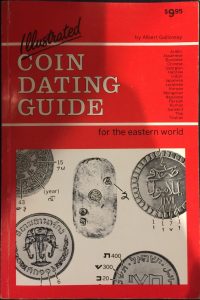 Over the last few months, I have been on another book buying binge. Most of the books I have been buying are references. Many of these references help fill in some of the gaps in my knowledge. One of those gaps is how to date some foreign coins especially those of the eastern world whose language is not Latin-based.
Over the last few months, I have been on another book buying binge. Most of the books I have been buying are references. Many of these references help fill in some of the gaps in my knowledge. One of those gaps is how to date some foreign coins especially those of the eastern world whose language is not Latin-based.
Although the Standard Catalog of World Coins has a basic reference to help figure out the date of a coin, it is not detailed enough. While there are websites on the Internet to help, there is not a single good resource. I wanted a good resource to help me grade these coins. Then I stumbled across the Illustrated Coin Dating Guide of the Eastern World by Albert Galloway.
Published by Krause Publications, it features the tables and descriptions that are in the Standard Catalogs on steroids plus much more information. The absolute best part of this book are the images with the guides pointing to each element to help identify the date coin.
Some coins are not dated but contain the number of years of the current ruler or dynasty. Coins from Israel use the date on the Hebrew Calendar while many Islamic countries include the date of the Islamic or Hijri Calendar.
Sample Pages
And it helps in more ways than figuring out the dates. If you are not familiar with the pictograph-style writing of some East Asian countries, having in the information in front of you can help identify the difference between a Korean coin from a Japanese coin, something that recently helped me.
Also, the book points out how to identify elements like mintmarks, privy marks, coiners marks, and other identifying varieties on these coins. As we know, a mintmark or other distinguishing mark can make a difference in a coin’s value.
The book was first published in 1984 and republished in 2012. Both versions appear to be the same with a color variation of the cover—the 1984 publication has a predominantly red cover.
The only complaint about the book is that it should be spiral bound so that the book could lay flat on the table. I have not had the book long and I have already bent the spine. At this rate, the book may not last long. For that reason, I give the book a grade of MS-69. If you are searching through lots of foreign coins, this book is a must-have for your numismatic library.
Aug 10, 2018 | books, Red Book
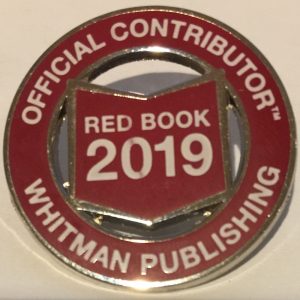 Although the 72nd edition of A Guide Book of United States Coins has been out since April, it seems like Whitman is doing a bit of behind the scenes reorganizing for the future. With Ken Bresett taking on the title of Editor Emeritus and Jeff Garrett taking over as Senior Editor, they seem to be a bit behind in some minor, but for some of us, important recognition. 😉 I finally received an Official Contributor’s pin for being a contributor to the Red Book.
Although the 72nd edition of A Guide Book of United States Coins has been out since April, it seems like Whitman is doing a bit of behind the scenes reorganizing for the future. With Ken Bresett taking on the title of Editor Emeritus and Jeff Garrett taking over as Senior Editor, they seem to be a bit behind in some minor, but for some of us, important recognition. 😉 I finally received an Official Contributor’s pin for being a contributor to the Red Book.
First, this is my public THANK YOU to Whitman for the pin and allowing me to participate!
As I did with last year’s edition, I participated in updating modern coin prices. Modern coins are those classified as being struck after 1964 when silver was removed from most U.S. coins. These are the coins that some dealers do not show a lot of love for because they are not perceived as worth the effort to sell. Although some of that has changed since the State Quarters were first introduced in 1999, the hobby should show more respect to these coins especially since we are 54 years into the modern era.
Although many feel that the Red Book’s pricing is obsolete when it comes out, it is still a good guide to understanding the foundation of pricing even if there is are market fluctuations. Thus, it would not hurt to get these prices closer to being correct, especially for new collectors. After all, this is a “guide,” not a price list.
This past year was a little different. Aside from not giving us a lot of time to enter prices (more on that later), my new business venture allows me to see the market from a dealer’s perspective. Even though I deal in general collectables and not just coins, I can now view the market from both sides of the counter.
Because of time constraints, I concentrated more on proofs and special issues than the business strike versions.
One of the reasons why the period for submitting our prices was delayed was that when Jeff Garrett took over as Senior Editor, a source said that he wanted to change a few things about how this was done. No details were provided.
I am speculating that the delay in sending out the contributor pins, which also comes with a copy of the Red Book and a Mega Red, is likely because Whitman is working diligently behind the scenes to make it easier for contributors to continue to help while giving Jeff and others a better platform for which to edit the prices.
Even though the Red Book is a good resource there are always ways to make it better. I am sure that Jeff will do a great job and hope that I can continue to contribute to the effort.
 As the times change, traditional hobbies have to find new ways to reach a new audience. The Royal Canadian Numismatic Association (RCNA) tried something different and published a new children’s book.
As the times change, traditional hobbies have to find new ways to reach a new audience. The Royal Canadian Numismatic Association (RCNA) tried something different and published a new children’s book. One Little Coin is written in English and in French as Une Petite Monnaie.
One Little Coin is written in English and in French as Une Petite Monnaie. → Read more at california18.com
→ Read more at california18.com
 → Read more at canadiancoinnews.com
→ Read more at canadiancoinnews.com
 → Read more at philstar.com
→ Read more at philstar.com
 → Read more at the-sun.com
→ Read more at the-sun.com
 I am getting ready to open the next chapter of my life, and I was thinking about how I can leverage my knowledge and experience to enhance the collecting community. As an experienced collector of all types and a dealer in areas other than numismatics, I learned a lot about collectors and their habits that could benefit a general audience.
I am getting ready to open the next chapter of my life, and I was thinking about how I can leverage my knowledge and experience to enhance the collecting community. As an experienced collector of all types and a dealer in areas other than numismatics, I learned a lot about collectors and their habits that could benefit a general audience.


 Even as some areas of the country are easing quarantine restrictions, the best way to prevent the spread of
Even as some areas of the country are easing quarantine restrictions, the best way to prevent the spread of 







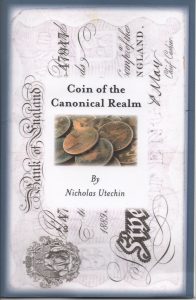
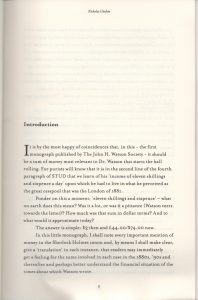
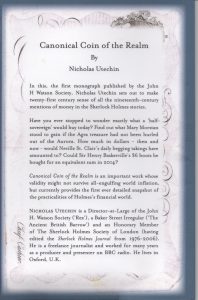
 While searching for something else, I came across a story that
While searching for something else, I came across a story that  Krause Publications publishes more than numismatic-related magazines and books. Many of their books are collector and buyers guides for other hobbies. Books like Antique Trader Antiques & Collectibles, Warman’s Antiques & Collectibles, Goldmine Price Guide (vinyl records), and Military Trader magazine define these industries.
Krause Publications publishes more than numismatic-related magazines and books. Many of their books are collector and buyers guides for other hobbies. Books like Antique Trader Antiques & Collectibles, Warman’s Antiques & Collectibles, Goldmine Price Guide (vinyl records), and Military Trader magazine define these industries. 
